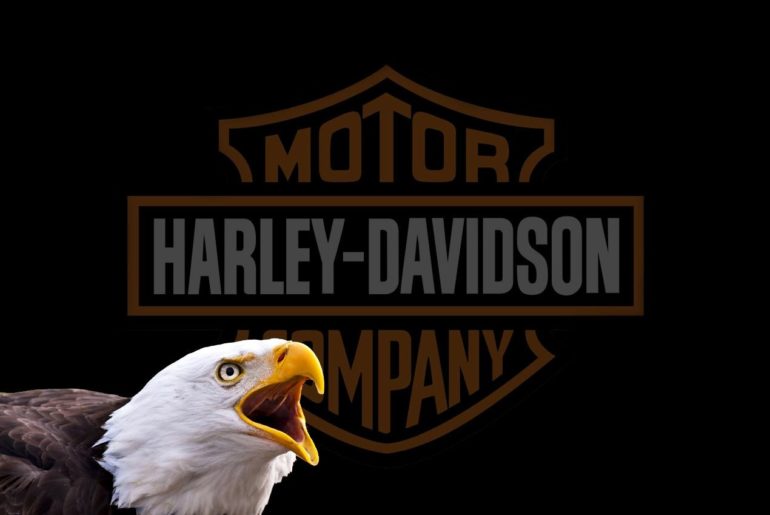There were high fives heard all over Milwaukee last week. Reading the headlines and stories that came from Harley-Davidson’s Mega Monday announcement, one could only conclude that the American icon was back. They did it. They were showing signs of life again. Boomshackalacka.
No one saw an adventure-touring bike with knobby tires coming from the Bar & Shield brand, and the idea of a sport bike from Harley-Davidson seemed inconceivable just over a week ago as well.
Milwaukee even impressed with its more “core” offerings, with the Harley-Davidson Custom being perhaps the first cruiser we would want sitting in our garage. It looks gorgeous, and is just sporty and modern enough to be “a real motorcycle” in our eyes…we think.
Let us too not forget that the iconic American brand is poised to lead the motorcycle industry with the first full-size, production, electric motorcycle from an established OEM. Stodgy, old, conservative Harley-Davidson will be an industry-leader this time next year, with its Livewire machine. Crazy.
Sprinkled into the news was a look at Harley-Davidson’s lineup of electric vehicles, which creates a pathway for non-riders to become diehard Harley-Davidson enthusiasts.
Harley-Davidson talked about its plans abroad; its desire to make entry-level / price-point motorcycles; its goal to add more riders, from more diverse demographics; its plans to add another engine platform that would range from 250cc to 500cc in displacement, and power bikes for the American, European, and developing markets.
Oh yes, there were certainly high fives heard all over Milwaukee last week, but it wasn’t because everyone was talking about all of this information that Harley-Davidson sprung on the motorcycle industry.
Instead, there were high fives in Milwaukee last week because no one was talking about Harley-Davidson’s shrinking Q2 sales, or the fact that the company’s stock price dropped 0.5% on the news.
Let’s Back Things Up a Minute
Before we dive too deep into all of this, let’s take a minute to realize what Harley-Davidson said, and didn’t say. What was actually announced by Harley-Davidson? After all, they showed us four new motorcycles with virtually no context, no specifications, and no prices.
Three of the four motorcycles are two years away, and the other (the Livewire) we have known about for several years now. A number of concept sketches were released as well, showing a robust EV lineup, but they could be up to five years out from reality.
Harley-Davidson also listed a number of strategies on how it is going to change. Small-displacement machines, growth abroad, electric vehicles, an Indian partner, a “modular” large-displacement DOHC engine platform, younger riders, female riders…
In business school, we used to make this scorecards for B-School BS Bingo, with terms like “blue sky thinking” or “paradigm shift” written on the squares…the above reads like the motorcycle industry version of that concept.
Pick the top five or six business trends percolating in the motorcycle industry right now, and compare them to Harley-Davidson’s action-item list for its brave new future. If Harley-Davidson could have wedged autonomous vehicles in there somehow, I would give them a perfect score on the effort.
The truth is, any one of these bikes by itself would have been a sizable media moment, and a tectonic shift for the Bar & Shield brand.
Any one of these new business strategies would have been a sea change for the Harley-Davidson brand, and don’t forget that the very mentioning of a future bike’s concept process is unheard of for Harley-Davidson.
So what do we make of not one, but four, new bike announcements? What do we make of the roughly half a dozen new business strategies being implemented? How do we feel about everything but the kitchen sink being thrown into this single press release?
This is what desperation looks like.
There are desperate times for Harley-Davidson. Yes, the American motorcycle industry is contracting (Harley-Davidson accounts for half of the big bike sales in the United States though, so there is a chicken and egg thing going on here to a certain extent), but Harley-Davidson is struggling with a bigger problem.
For almost a decade now, we have been talking about Harley-Davidson’s aging demographic. We have warned that the day that would come, when the baby boomers would be too old to buy another Harley-Davidson motorcycle.
We lamented Harley-Davidson’s laser-like focus on a single demographic of rider, at the cost of alienating all others. We lambasted the company for its 31 flavors of the same motorcycle, which always seemed to be stuck in a forgotten past.
We cringed at the faux-Patriotism that this star-spangled-awesome American brand used, in order to sell us a piece of “freedom” on the open road.
When business was good, business was good. But now, the baby boomers are dying off, women make the majority of the purchasing decisions in the United States, the post-authentic motorcycle movement is waning, Harley-Davidson is shipping more of its production overseas, and sales are in a free fall.
This idea that business can continue as usual has finally run its course. It took Harley-Davidson 10 years to realize it, but it is better late than never.
This brings us back to last week, the new bikes, the new strategies, the Q2 sales, the kitchen sink, and all those high fives.
Getting Credit for What You Are Supposed to Do
I remember reading another publication’s breakdown of Harley-Davidson’s new business strategy. It was glowing, as were the dozen or so Harley-Davidson ads on the page next to the story (on top of the story, behind the story, popping-up to the side of the story, in and around the story area).
I also remember asking myself when did we start giving credit to people, or businesses (which are people, in the eyes of the government), for the things that they are supposed to do?
Chris Rock explains this idea far better than I can, but as we learned from Michael Scott on The Office, re-telling that theory can be difficult.
Too many times in this industry over the last week have I heard Harley-Davidson praised for their bravery in this radical new direction. But, we shouldn’t give credit for things that a company is supposed to do.
We shouldn’t give credit when Harley-Davidson says it wants to target younger riders, or female riders, or riders from minority groups – a good motorcycle brand is supposed to do that already.
We shouldn’t give credit when Harley-Davidson enters a new motorcycle segment or developing market, nor should we give credit when it debuts a new modern engine or electric vehicle platform – a good motorcycle brand is supposed to do that already.
It is 2018, which means that too many years have gone by for these junior varsity ideas to be considered bold, innovative, and progressive move for a major-league hitter like Harley-Davidson.
Quite simply, for as long as I have been in this industry, we have been asking why Harley-Davidson wasn’t already making inroads to new buyers, exploring new markets, and creating truly “new” motorcycles.
By my scorecard, the Bar & Shield brand is ten years late. Just like my third-period French class in high school, you don’t get extra credit if you show up late.
A Fish Out of Water
Timeliness aside though, Harley-Davidson’s new business plan is a strong one. It better be, after all, since it reads like the greatest hits album from the motorcycle industry’s collective opinion writers.
While I boo the reception, I applaud the plan. It is right, it is correct, it is sound from a business perspective, and it is so much harder to achieve than it is to say – and let’s still remember that it took Harley-Davidson over a decade to say it.
While I have no problems giving Harley-Davidson some razz for finally getting with the program, where my real worries reside are in the implementation of CEO Matt Levatich’s plan.
Nothing about what Harley-Davidson is about to build is within its core competency, not to mention the challenges in reaching a new demographic, in new territories, and so on and so on.
To make matters worse, I am not sure Harley-Davidson knows what it doesn’t know – and if they told me they did, I’m not sure that I would believe them.
Let me illustrate my point with an anecdote. I got a call phone call about two years ago from an American motorcycle brand, and they wanted to know my thoughts about what was generally required to compete in the sport bike segment.
I talked about the different expectations of a sport bike motorcycle, like brakes, engine power, tires, and electronics. I mentioned a few performance metrics, a few OEM brand partners, and a couple key price points. I finished off my thoughts with a basic project ethos and marketing communication strategy.
I talked for just a couple minutes, hitting the high-points of my thoughts, expecting a follow-up discussion on each topic to follow. What I heard was silence, and I assumed that the silence was due to the scribbling of notes on the other end of the phone.
Final hearing the pause in the conversation broken, my phone crackled. “Uhh, yeah. Interesting stuff…but we were thinking of just doing something like a different fuel tank shape, and maybe a racing stripe on the paint.”
This is the disconnect between the two halves of the American motorcycle industry, and why I often say we should remove Harley-Davidson from the discussion when we are talking about basic motorcycle industry trends.
This is a brand that has existed in its own two-wheeled bubble for decades, and the effect has been a complete disconnect of Harley-Davidson from the outside motorcycling world.
When I see Harley-Davidson refer to its 1,250cc adventure-touring bike (which I suspect will weigh close to 600 lbs), as a “middleweight” motorcycle, I see signs of this disconnect. Because while such a machine would be a “heavyweight” in any other brand’s lineup, in Harley-Davidson’s world, 76 cubic inches is still fairly small in stature.
Similarly, when I see its Streetfighter sized a 975cc, with a belt drive and no obvious provisions for electronics, I wonder if the product development team really knew what that name means to every other rider outside of Milwaukee, and what expectations come with it.
I wonder too if there is a reason that the new Livewire electric motorcycle got restyled to look more like a Sportster – you know, the motorcycle that Harley-Davidson dealers pitch as the motorcycle for the wife (we’ll just skip the obvious sexist overtones on that one).
And while Harley-Davidson’s electric platform is intriguing, how will an e-bike or electric scooter sell when its standing next to 24 different colors of Harley-Davidson bandanas, an assortment of leather assless chaps (all chaps are assless, by the way), and the timeless “the bitch fell off” t-shirts?
You see, while the hardest challenge for this iconic American company is overcoming its own success in the past, because that success has cost the company its future, the second hardest challenge facing Harley-Davidson is for the brand to stop acting like Harley-Davidson.
In short, Harley-Davidson has to relearn how to be a motorcycle company…or more cynically, it needs to learn how finally to become a motorcycle company.
This is an amazingly difficult thing to do, and while I think Harley-Davidson is capable of overcoming the challenges I just mentioned, there is a huge difference between talking about something and actually doing it.
The Proof Is in the Pudding
I say, we reserve the judgment, and the high fives, for when Harley-Davidson actually delivers something tangible.
Lets see the specs on the new Pan America model, and see whether it is more Caponord or more 1290 Adventure. Similarly, let’s see how potent this new dual-overhead cam engine can be, and whether it is more Buell or more Ducati in its performance.
I want see how Harley-Davidson is going to pitch motorcycles, real motorcycles to someone like myself, instead of someone like my father.
In fact, Asphalt & Rubber is the biggest litmus test I can think of for Harley-Davidson. Win over the hearts and minds of our readers, our writers, and our editors, and I will show a brand that has successfully reached beyond its core demographic.
I understand the reasons why Levatich and his team needed to come out swinging last week with signs of life at Harley-Davidson. Dealers are hurting, consumer confidence is low, and stock prices are dropping. Something had to be done, and it had to be done in a meaningful way.
Going into Sturgis, one of the brand’s biggest events of the year, the talk will surely be all about these four “new” Harley-Davidson motorcycles, where the Bar & Shield brand is headed, and what kind of sound the Livewire makes.
But when the dust has settled in South Dakota though, Harley-Davidson will still be facing the same problems that it had a week ago before these announcements: an ailing market, an aging demographic, and uninspired product lineup.
That will then be the point where Harley-Davidson has to trade those high fives for actual action. I hope they are up to the task. It’s only the future of the company that’s at stake.




